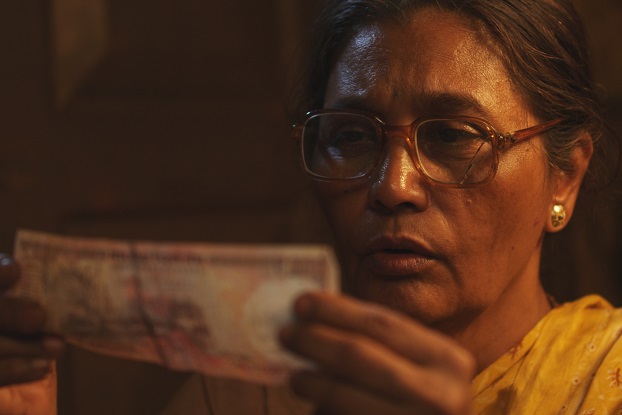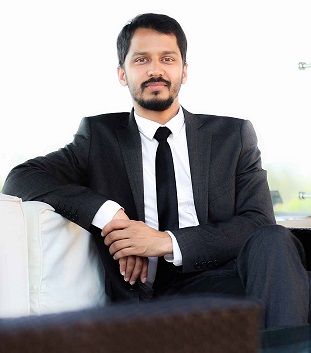
Award-winning filmmaker Shrihari Sathe has produced 22 independent films set around the world from Bosnia and Herzegovina to Buffalo, New York. Sathe is someone who believes a good story goes beyond borders and languages, whether it is told in Spanish or Pashto. His directorial debut, acclaimed Marathi movie 1000 Rupee Note (Ek Hazarachi Note), is making its U.S. theatrical debut this Friday in New York City.
At the center of the film set in rural Maharashtra is Budhi, a poor widow who knows the plight of farmers all too well. Working as a maid and subsiding on very little, Budhi’s luck takes a turn when she is suddenly gifted a sizable sum of money. Viewers join Budhi on the journey the rupees take her, which is both joyous and heartbreaking. Sathe, who also wears the hat of adjunct assistant professor in the Film Department at Columbia University’s School of the Arts, tells The Aerogram more about the road to making 1000 Rupee Note and the unique relationship people have with money.

You’ve produced a number of films but 1000 Rupee Note is your directorial debut. Why did you want to direct this story? What was your experience like?
When I first read Shrikant Bojewar’s short story I was totally taken with the simplicity and the themes it explored. The material, without hitting the nail on the head, subtly said a lot about the state of modern India and contemporary rural society. I was attracted to the character of Budhi, who in my opinion resembles a majority of the Indian population — rural and poor but one that finds happiness in small things in life. I was very happy to be back wearing a director’s hat after being a producer for so many years. Directing seasoned actors was a delight and I’m looking forward to my next film.
You’re a Mumbaikar with degrees from America who lives in New York and produces stories from around the world. Would you say 1000 Rupee Note marks a certain homecoming?
It’s been very rewarding to make movies outside of India both creatively and in terms of career goals but I’m from India and I grew up there. I had always wanted to make movies in India, particularly movies on stories that weren’t being told as much. I had started developing projects to make in India back in 2005. The first project was something actually I wrote with my dad — a Tamil/English language film based on the life of eminent mathematician Srinivasa Ramanujan but we soon realized there were many other projects floating around and thus we temporarily shelved the project as my American projects were starting to come together. So when 1000 Rupee Note was greenlit I was very happy to finally have a film in India, and it’s been a great homecoming to see the audiences at home embrace the film.
1000 Rupee Note is the first film you’ve produced in India. How is producing in India different compared to other countries?
In 2007, while I was finishing my MFA-Film at Columbia University School of the Arts, I took a short sabbatical to assist Rakeysh Omprakash Mehra on his film Delhi-6. I spent almost a year working on that film and then returned to NYC to finish my degree. Since that time I wanted to come back to India to produce a film but my projects in the U.S. took precedence and I produced a few feature films in the U.S. and a couple short films internationally. During those years along with producing and developing projects I was looking for a script for me to direct.
When Shrikant and I started developing the material for 1000 Rupee Note (Ek Hazarachi Note), I knew this was the film I wanted to do. It was a low budget production, something I could pull off given limited resources and the themes most interested me. Producing in India was actually not very different to making movies in other countries. The cast and crew were very professional, the equipment is world class. The only big difference is the size of the crew. We had a much larger crew compared to if all things equal making the same movie in the U.S.
With Marathi cinema garnering much attention for original, quality content, did you feel your story would have a more receptive audience with 1000 Rupee Note in Marathi vs Hindi, especially when considering theatrical release in India?
When Shrikant and I were developing the story we hadn’t decided on what language to make the film in as we wanted to develop a story and characters that could be universal. We worked on the script through themes and emotions. I had thought about making the film in Hindi and at one point even in Tamil but Marathi won out as both the screenwriter and I hail from Maharashtra. Once Marathi was selected we wanted to get a bit more specific to give the setting a character and flavor of its own and decided to do the dialogues in Varhadi, a dialect of Marathi (the dialect spoken in this part of Maharashtra). Shrikant is originally from the Vidarbha region so his fluency of the dialect helped. We engaged a dialect coach to help the actors achieve the certain inflection while delivering their dialogue.
Did you have any exposure to rural India/rural Maharashtra previous to making this film?
As a kid, while growing up I had traveled around Maharashtra and other parts of India, either for trekking or for camps. I had traveled in the Vidarbha region about 5-6 years back to research a feature film I was developing then so the pictures, videos and meetings I took during that time helped shape the visuals for 1000 Rupee Note. I hope to be able to make that original project soon as it’s much bigger in scope.
The lovely opening credits feature tribal children taking part in a custom, going home to home while singing. Can you tell me more about the ceremony, its significance and why it was featured in the opening?
The opening song “Dhondi Dhondi Pani De” written by Shrikant Bojewar and composed by Shailendra Barve is based on an old tribal song where tribal boys in this particular part of India (Vidarbha region) pray to the Rain God for rain. They go from house to house all over the village asking for alms and singing the song. I wanted to open the film with this song to introduce the audience to this part of the world and to the characters.
Vidarbha region suffers from drought pretty often and to this day tribal children follow this ritual of asking the Rain God for rain. There’s a crazy anecdote from when we were filming this sequence. It was April’s end (middle of summer in India) when it almost never rains and while filming this sequence, about half way through the day it actually started raining. Uncanny.
Playing Budhi is Usha Naik, who was known for her dancing prowess earlier in her career in Marathi cinema, and currently stars in Marathi serials. What made you decide on her as Budhi? What was it like working with her?
Before 1000 Rupee Note (Ek Hazarachi Note) I hadn’t worked in India in a while and so wasn’t familiar with actresses in the age range for Budhi’s character. We brought Chinmay Kelkar onboard to help cast the film and held auditions in Nagpur, Pune and Mumbai for pretty much all the major roles in the film. I hadn’t seen Usha Naik’s recent work before I met her regarding the film. I admired the fact that she was willing to audition even though she’s been acting for over 30 years.
We held a couple sessions and I knew that she was the perfect choice as Budhi. I was looking for someone who could portray pathos and one’s inner child without being too melodramatic and over the top. It was a great experience working with her. She was very open to my process and willing to give it her all while we were filming. The shoot was quite rigorous as Budhi is in almost every scene but Ushaji was fully committed to the character and the film.
As stated in the film during a crucial scene, “when the Goddess of wealth arrives, she brings trouble with her too.” 1000 Rupee Note shows the relationship people have with wealth in a fascinating manner. What is the message you wanted to convey in regards to how people see themselves and relate to one another when money is involved?
I think that the value of money is very relative to the person in whose hands it is. It also inherently exposes their moral values. I wanted every character in the film to display their own underlying values through their relationship with money, be it 2 Rupees, 1000 Rupees or lakhs of Rupees.
Why did you dedicate this film to your grandparents?
I grew up around three of my grandparents. Even though I never met my paternal grandfather, he’d passed away before I was born, I had heard stories of him from my grandmother, dad and aunts. All four of them found happiness in small things in life, their friends and families.
The film has won many awards and received accolades. Why do you think the film has resonated with audiences? Is there a comment or compliment that is very special to you?
It’s wonderful to find that the film is resonating with audiences in various parts of the world. I’ve received great feedback via social media from audiences in rural India to audiences in Durban (South Africa), Mill Valley (USA), Orlando (USA), Madrid (Spain) and Ischia (Italy) amongst other parts of the world. Even though the film is specifically about a poor old woman in the Vidarbha region of Maharashtra, the emotions are universal.
What is next for Shrihari Sathe?
I’m currently developing the script for Goodbye Mr. Kanay, my second feature as director. It’s exciting to collaborate again with Shrikant Bojewar who wrote 1000 Rupee Note (Ek Hazarachi Note). We recently received the Script Development Fund from the Asian Cinema Fund (Busan International Film Festival). I’m aiming to shoot next year. I have two other films in development that I am producing — Ritu Sarin and Tenzing Sonam’s The Sweet Requiem, a film in Tibetan language set in India and Tibet and, Bassam Jarbawi’s Mafak (Screwdriver) in Arabic language and set in West Bank, Palestine.
* * *
1000 Rupee Note (Ek Hazarachi) opens at New York’s Village East Cinema tomorrow, September 23 and runs through September 29. For tickets and showtimes, visit https://www.citycinemas.com/villageeast/showtimes-and-tickets/now-playing
Shivani cannot remember a time when she wasn’t madly in love with Indian cinema, which now inspires much of her writing. She lives in both New York City and Twitterpur at @Shivani510.












